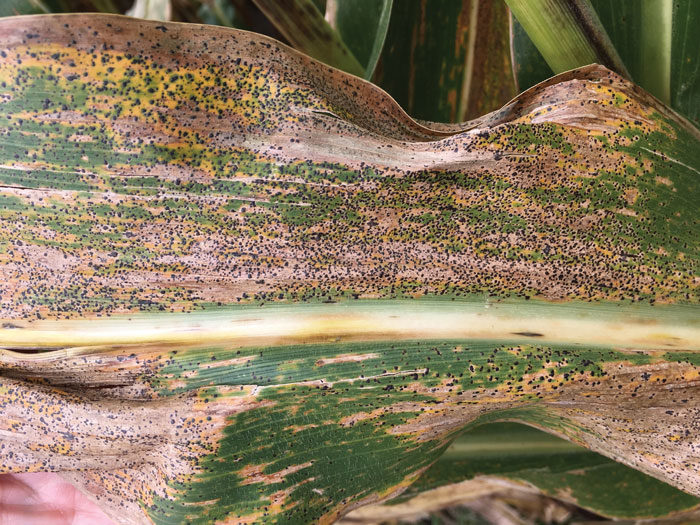A recent study shows U.S. corn growers are facing an elusive yield robber in the rapid spread of tar spot infection. The pathogen infecting their fields is a multi-headed threat from related, but genetically different, species.
Tar spot is a condition blamed on a fungal infection of Phyllachora maydis and has been known to cause yield losses of up to 60 bushels per acre in untreated fields. It appears as small, raised black spots scattered across corn leaf surfaces. These fungal fruiting structures interfere with photosynthesis.
Costly Disease
First noted in the U.S. in 2015, the disease spread rapidly across much of the Corn Belt, costing an estimated 241 million bushels of production between 2018 and 2020. Today, the disease has been detected throughout the Corn Belt eastward to Pennsylvania and in the southeast in Georgia and Florida.
Until recently, scientists thought the disease was new to the U.S. and that it was not capable of infecting species other than corn. However, a study published in Ecology and Evolution in April 2022 complicates that view after studying field samples of corn residue and several other grass species.
The study indicates five genetically distinct Phyllachora species — not just Phyllachora maydis — are at work, three of which are currently found in the U.S.:
- Species 1 — Found only in corn from field samples in Indiana and Ohio.
- Species 2 — Found in dried corn samples from Columbia and Puerto Rico, as well as corn field samples from Puerto Rico, Mexico, Florida, Illinois and Michigan.
- Species 3 — Found in several U.S. states and a dozen other countries. Also found in 10 other host species of grasses and flowering plants. This was first species identified in the U.S. in 2015 and can be traced as far back as 1904 in Mexico. Dried plant samples indicate this species has been present in grasses in the U.S. since at least the 1940s, but not in corn.
Stop the Spread
Agronomists and crop consultants recommend corn growers have plans in place for combatting tar spot by selecting tolerant hybrids and planning timely fungicide applications.
Purdue University Extension plant pathologist Darcy Telenko has been working with Indiana and other area farmers on tar spot since it first appeared. She says moisture is key to the severity of the disease. Favorable environmental conditions, such as 85% relative humidity with more than 7 hours of leaf wetness, promote infection and disease development.
“Wind-driven rain and storms can spread the spores of the pathogen to new plants and continue to spread the disease to new locations in the U.S.,” Telenko says.
Telenko urges no-tillers to be aware of the likelihood that the disease is present in their or their neighbors’ fields. An online map available at corn.ipmpipe.org tracks the presence of the disease in the U.S.
“If it’s not on your farm or confirmed in your county now, it likely could be active there next season or in coming seasons,” she says. “It is important to be aware of the disease in your area and be on the lookout.”
Management Options
Beyond hybrid resistance, which is the most popular and effective tool for managing the disease in Latin America, timely application of fungicides may help reduce tar spot for North American no-tillers if they stay aware of infestations by thoroughly scouting their fields during the season.
Telenko recommends consulting the online Crop Protection Network fungicide efficacy table for tar spot and other diseases. The list is compiled by land-grant university plant pathologists across the country and is regularly updated.
Wisconsin’s Tarspotter app is also a good resource. It can be used to determine if weather conditions are favorable for the disease in a specific area. It is designed for use with V8 corn through R4 (dough) and shows field risks by color codes.








Post a comment
Report Abusive Comment